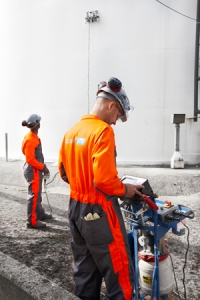Corrosion management in storage facilities
Corrosion control and management is a critical component to the proper operation and maintenance of a number of facilities and structures in the energy industry. Due to the harsh nature of the chemicals, contaminants and corrosive elements in contact with metal tanks, pipelines, terminals, plants and platforms, the chance of degradation is higher when there is consistent exposure over time. Because of this, corrosion is the No. 1 cause of storage tank failures, according to NACE International.
Combating corrosion is paramount to maintaining the security of infrastructure both on site and further downstream. Because storage facilities house millions of barrels of oil, liquid gas and other petrochemicals, the strength of these tanks is constantly tested by corrosion. Prior to transport, much of the nation’s vital resources are stored in these structures, and without effective non-destructive testing (NDT) protocols in place, operators may not be aware of the precise condition or safety of these edifices.
Fortunately, the energy industry has achieved several breakthroughs in recent years, with technology advancing to the point where corrosion management is now a key real-time practice that focuses more on prevention than simply taking a reactive approach.
“Noncorrodible materials are not impacted by rusting or oxidization.”
Coatings
Prior to putting facilities into production, metallic and organic coatings are applied, which provides a complete seal against leaks and excessive corrosion. These coatings are able to fill gaps and narrow joints along bond lines, thus providing protection even in parts of the structure that are hard to inspect.
NACE International noted 50 percent of all corrosion is preventable, with coatings being a primary resource that engineers and on-site technicians use. In addition, coatings can also be applied in layers or even after the storage facility is being used. This enables operators to ensure the entire structure is being updated and fully insulated from the damaging effects of corrosion.
Durable materials
Operators of underground storage tanks (UST) are aware that concrete or metal tanks are prone to oxidization and potential loss of structural integrity. The Texas Commission on Environmental Quality stated those constructing new storage facilities can opt for more durable materials like fiberglass to help thwart the advancement of corrosion. In fact, these types of noncorrodible materials are not impacted by rusting or oxidization, however, the metal components that connect the tank or piping shells may be.
Further, operators now commonly install a secondary containment system around storage tanks designed to capture leaks from the primary tank and to prevent a release to the environment, with the added benefit of being able to monitor the space between the primary and secondary containment, defined as the interstitial space, to detect a release and to take action prior to a release to the environment .
Cathodic protection
UST systems also benefit from cathodic protection, which is an engineering procedure that sends electric currents through the material and prevents corrosion from occurring. One of these methods (Galvanic) actually installs a zinc or magnesium anode connected to the structure, which then redirects oxidization away from the tank’s materials onto this “sacrificial anode.”
“NDT provides critical data that helps mitigate risks and continue safe operation of infrastructure.”
A second variation of cathodic protection (impressed current) allows engineers to gauge and adjust the electrical current sent through the walls so protection is extended over larger surface areas.
Routine NDT
Most corrosion begins as minor pitting or cratering, which allows chemicals or stored liquids to pass through corrosion holes and exit the tank. In addition to installing protective jackets around tank walls and lining the interior of the structure with protective coatings, operators should also conduct routine inspections of the integrity of tanks both below and above ground. These testing procedures not only protect valuable on-site assets from downtime or system failure, but they also allow operators to fully comply with applicable environmental regulations, specifically the Energy Policy Act of 2005 and the Spill Prevention, Control, and Countermeasure Rule.
New NDT techniques are also becoming industry standards, which creates uniform safety protocols for operators and service providers to follow. For instance, automated ultrasonic mapping systems utilize ultrasonic technology to map the thickness of a wall and isolate areas of corrosion that may have previously been hidden or difficult to detect. Similarly, various eddy current and thermal testing techniques can identify potential weaknesses in storage tanks, alerting operators to the warning signs of corrosion. These types of assessments provide the critical data the industry requires to mitigate risks and continue safe operation of all infrastructures.
